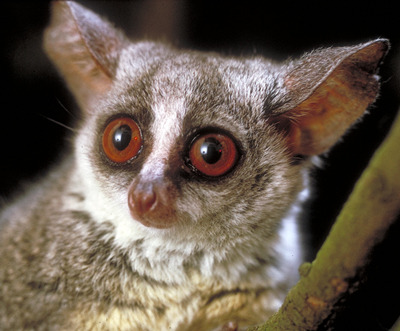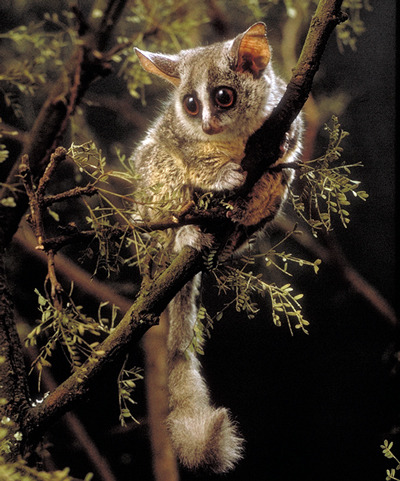#Galagidae
Text



Go Go Southern Lesser Galago!
Also known as the South African galago or the mohol bushbaby, the southern lesser galago (Galago moholi) is a small primate from the Galagidae, or bushbaby family. As the name implies, they are located only in southern Africa, from northern South Africa up to Rwanda. Their preferred habitats are savannahs and semi-arid woodlands, where they can often be found high in the canopy, and they are particularly associated with Acacia trees.
The mohol bushbaby is one of the smaller members of its group; at full height they stand no taller than 15 cm (6 in) and weigh only 225 g (7.9 oz). In fact, their tail is longer than their body, easily reaching 23 cm (9 in) in length. While it isn't prehensile, the tail is still an important tool for climbing as it gives G. moholi an excellent sense of balance. Along with their incredible tails, the South African galago also has one of the largest sets of ears of any primate, proportional to its size; these ears can move independently to help the southen lesser bushbaby avoid predators. G. moholi's final distinguishing feature are their eyes, which are incredibly large and a distinctive orange color. Individuals themselves tend to be gray or light brown, which helps them blend in with their surroundings.
South African galagos are almost strictly nocturnal. At night, they forage through the canopy for moths and beetles. These bits of protein, however, are supplemental; the mohol bushbaby's primary source of food is gum, or hardened sap from the Acacia plant. G. moholi has several adaptations allowing it to specialize in gum extraction, including scraping teeth on the lower mandible; long, rough tongues; and digestive systems that have evolved to break down and ferment the tough substance. Because they have very few defense mechanisms, southern lesser galagos are a common prey for many nocturnal species like eagles, owls, snakes, mongooses, civets, and gennets.
One of the few ways the South African bushbaby avoids predation is through its social units. Groups of 2-7-- typically composed of a female, her young, and a few non-reproductive relatives-- forage together. In these groups, their collective night vision and highly-developed hearing allow them to detect and alert each other to predators long before the threat is immanent. While individuals forage seperately, they keep in contact via loud, high pitched calls that can serve as a warning for predators, a point of contact between mother and offspring, or a territorial warning between males.
Male G. moholi live seperately from social groups, and are highly aggressive against other males invading their territory. This area often overlaps that of several female-led groups, but they only come in contact with each other during the mating season. Unusually, the species has two mating seasons through the year; from January to Februrary (late summer) and from October to November (early spring). Following a gestation period of 120 days, females produce a single set of twins each mating season. Each set is weaned after approximately 3 months, and young become fully mature at 300 days. Female offspring may join the mother's group, while males leave to establish their own territory. In the wild, an individual may live up to 16 years.
Conservation status: The IUCN has classified the South African bushbaby as Least Concern. Studies have indicated that the population is stable and, in some areas, increasing. However, in other areas the species is threatened by habitat loss and possibly capture for the pet and bushmeat trade.
If you like what I do, consider leaving a tip or buying me a ko-fi!
Photos
Gerald Doyle
Peter Webb via iNaturalist
#Southern lesser galago#south african bushbaby#Primates#Galagidae#galagos#bushbabies#mammals#savannah mammals#tropical forest mammals#africa#south africa#animal facts#biology#zoology
164 notes
·
View notes
Text

A pair of brown greater galagos (Otolemur crassicaudatus) in Mkhuze Game Reserve, South Africa
by Ik_kil
#brown greater galago#galagos#prosimians#otolemur crassicaudatus#otolemur#galagidae#strepsirrhini#primates#mammalia#chordata#wildlife: south africa#wildlife: africa
130 notes
·
View notes
Text
collecting creatures for you
Unique creatures (plants, animals, fungi) I have stumbled upon and wish to research more
This is mostly personal but I would appreciate it if you learn something new today + recommend me another critter to check out! Keep in mind I'm not an expert and if I put in misinformation, please tell me! I'll try to be quick in fixing my mistake
This post is constantly updated!
----
Galago, Galagidae (small nocturnal primates)
Also called "bush babies" or "nagapies" (night monkeys in Afrikaans)
They are found in forests in sub-Saharan Africa (below the Sahara) and they are mostly arboreal (reside in trees). Different galago species live in different climates ranging from tropical to dry and thorny. Their strong legs and long tails make it easy to scale and jump from trees
Their huge eyes (compared to their size) help them see at night
They are omnivorous and their diet consists of fruit, insects, frogs, and tree gum
Galagos are actually quite small- you can hold adults in the palm of your hand! The largest galago is the brown greater galago
Their nickname (bush baby) might come from the fact that their calls sound oddly familiar, like the cries of a wailing baby
They are sometimes kept as exotic pets
Bobbit-worm, Eunice aphroditois (predatory aquatic worm)
Also called "sand-strikers". Their primary nickname, the "bobbit-worm", comes from the John and Lorena Bobbit crime case. Be warned, I don't recommend digging deeper into the rabbithole
These worms can reach lengths up to 3 meters (nearly 10 feet)
They are actually quite beautiful and they have a shiny, "rainbow" exoskeleton
Bobbit-worms reproduce sexually but they do not mate. The female drops her eggs and the male drops his sperm on them and they leave the eggs to fertilize.
Crazily enough, bobbit-worms can also reproduce asexually as well by "splitting" into sections, but they usually do this to regenerate their parts instead of to reproduce
They use their snapping jaws and multiple antennae to hunt. The antennae are used to sense prey out of their burrow and they also might be used to "lure" prey to them. Their jaws are scissor-like and can cut prey cleanly in half.
I haven't found any sources for this, but I do think that their species name (the second part of the scientific name) means "Aphrodite", the ancient Greek god of beauty. No idea why though, the worms are terrifyingly beautiful...
#animals#science#zoology#idea#creature#interesting#cool animals#information#inspiration#creature inspiration
3 notes
·
View notes
Photo

1 note
·
View note
Photo

Take a night walk @ Rweteera Safari Park camp at Kibale forest in Uganda and look out for the nocturnal animals like Galago, Bush babies etc. Galagos, also known as bush babies, or nagapies, are small nocturnal primates native to continental, sub-Sahara Africa, and make up the family Galagidae. They are considered a sister group of the Lorisidae. According to some accounts, the name "bush baby" comes from either the animal's cries or its appearance. Book your stay at Rweteera Safari Park via WhatsApp +256776862153 #visituganda🇺🇬 #rweteerasafaripark #africanrivercamps #rivercampsuganda #bushbabies (at Rweteera Safari Park) https://www.instagram.com/p/CaK3cLCLiyR/?utm_medium=tumblr
0 notes
Video
. !! Rawr😂 !! . ___________________________________________ Galagos, also known as bushbabies, bush babies, or nagapies, are small nocturnal primates native to continental Africa, and make up the family Galagidae. They are sometimes included as a subfamily within the Lorisidae or Loridae. ___________________________________________ If you are a globe trotter and would like your pics featured, please tag us with #Ghumakkadd . If you fancy yourself as a writer or blogger, reach out to us via dm, email or Facebook. ___________________________________________ #fun #video #traveldiaries #amazing #love #world #instadaily #travel #wanderlust #lunch #peace #mountains #hilarious #potd #instagood #super #world #awesome #smile #traveling #place #great #instalike #wave #movies #india #Dolphin Video credits :
#india#hilarious#place#fun#love#instagood#mountains#potd#video#travel#dolphin#wanderlust#traveling#movies#world#instadaily#instalike#amazing#lunch#smile#wave#awesome#ghumakkadd#traveldiaries#great#peace#super
1 note
·
View note
Link
Senegal Bushbaby, Lesser Bush Baby - https://www.womanfemale.com/?p=18187 - Das Senegal-Buschbaby (Galago senegalensis), auch bekannt als der Senegal Galago, der kleinere Galago oder das kleinere Buschbaby, ist ein kleiner, nachtaktiver Primat, ein Mitglied der Galagosfamilie Galagidae. Der Name "Buschbaby" kann entweder aus den Schreien der Tiere oder aus ihrem Aussehen stammen. Sie sind agile Spinner und rennen schnell über Äste. Sie leben in Afrika südlich der Sahara und nahe gelegenen Inseln einschließlich Sansibar. Sie leben in trockenen Waldgebieten und Savannenregionen. Sie sind kleine Primaten (130mm und 95-300 Gramm) mit wollig dichtem Fell, das von silbergrau bis dunkelbraun reicht. Sie haben große Augen, die ihnen eine gute Nachtsicht geben; starke Hinterbeine; und lange Schwänze, die ihnen helfen, das Gleichgewicht zu halten. Ihre Ohren bestehen aus vier Segmenten, die einzeln zurückgebogen werden können, um bei der nächtlichen Insektenjagd ihr Gehör zu unterstützen. Ihre allesfressende Diät ist eine Mischung anderer kleiner Tiere, einschließlich Vögel und Insekten, Früchte, Samen, Blumen, Eier, Nüsse und Baumgummis. (Quelle: wikipedia.org) Verwenden Sie dieses Bild nicht ohne meine ausdrückliche Genehmigung auf Websites, Blogs oder anderen Medien. © 2012 Johannes Mayer, Alle Rechte vorbehalten. - #baby websites #behaviour #Canon EOS 400D #Galagidae #Galago #Galago senegalensis #lesser bush baby #lesser galago #mammalia #mammals #nature #night #night-shot #Nördlicher Galago #Primaten #Primates #Säugetiere #Senegal bushbaby #Senegal-Galago #Steppen-Galago #Tansania #Tarangire Nationalpark #tree gum #wildlife
0 notes
Text
General Naming Characteristics
The galago, or bushbaby, is a common name that refers to any of a number of species in the Galagidae family. Low estimates say there around a dozen different bushbaby species, but this is widely disputed among researchers (Primate Info Net). They are categorized as prosimians due to their prehensile tail, shorter arms when compared to legs, large eyes, wet nose, and claws (including a grooming claw) (New World Encyclopedia).
0 notes
Photo

While not native, I can be found in breeding-populations near Johannesburg and Pretoria. Some of us have migrated, but others are escaped or released pets.
1 note
·
View note